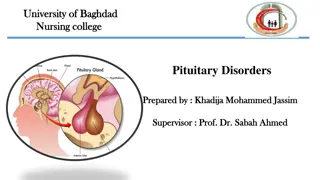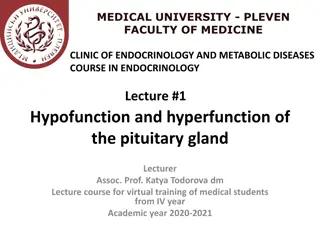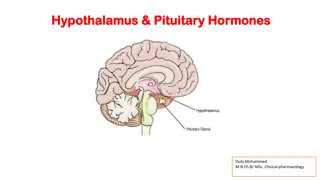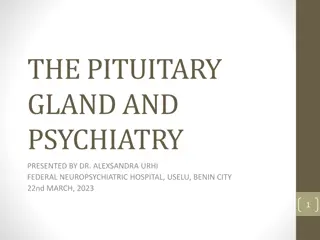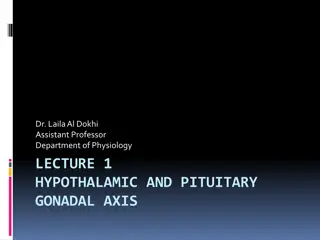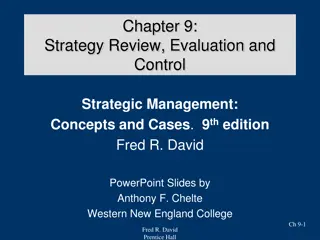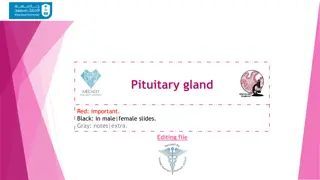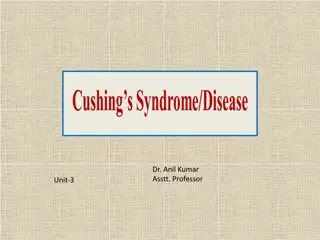Pituitary Incidentaloma: Evaluation and Management Recommendations
A pituitary incidentaloma is an unsuspected pituitary lesion discovered incidentally during imaging studies not done for lesion-related symptoms. Patients should undergo a thorough evaluation for hormone hypersecretion and hypopituitarism, including clinical and laboratory assessments. Recommendations are based on clinical experience due to sparse literature. Evaluation for hypersecretion should include assessing prolactin, GH, and ACTH levels. Data on prevalence come from observational studies and autopsy data. Valid estimates of abnormal pituitary function tests are challenging.
Download Presentation

Please find below an Image/Link to download the presentation.
The content on the website is provided AS IS for your information and personal use only. It may not be sold, licensed, or shared on other websites without obtaining consent from the author.If you encounter any issues during the download, it is possible that the publisher has removed the file from their server.
You are allowed to download the files provided on this website for personal or commercial use, subject to the condition that they are used lawfully. All files are the property of their respective owners.
The content on the website is provided AS IS for your information and personal use only. It may not be sold, licensed, or shared on other websites without obtaining consent from the author.
E N D
Presentation Transcript
A pituitary incidentaloma is a previously unsuspected pituitary lesion that is discovered on an imaging study performed for an unrelated reason. By definition, the imaging study is not done for a symptom specifically related to the lesion, such as visual loss, or a clinical manifestation of hypopituitarism or hormone excess, but rather for the evaluation of symptoms such as headache, or other head or neck neurological or central nervous system complaints or head trauma
1.0 Initial evaluation of a patient with a pituitary incidentaloma 1.1 We recommend that patients presenting with a pituitary incidentaloma undergo a complete history and physical examination that includes evaluations for evidence of hypopituitarism and a hormone hypersecretion syndrome.
1.1.1 We recommend that all patients with a pituitary incidentaloma, including those without symptoms, undergo clinical and laboratory evaluations for hormone hypersecretion (1+++ ). 1.1.2 We recommend that patients with a pituitary incidentaloma with or without symptoms also undergo clinical and laboratory evaluations for hypopituitarism (1+++ ) Some Task Force members recommend a minimal screening : free T4, morning cortisol, and testosterone levels Others: also measurement of TSH, LH, and FSH and IGF-I.
Evidence The goals of the endocrine evaluation of pituitary incidentalomas are to identify hormone hypersecretion and hypopituitarism. The recommendations for evaluation of pituitary function considered the likelihood of an abnormality in a given patient. However, valid estimates of the pretest probability of an abnormal test of pituitary function could not be definitively determined because literature on this topic is sparse. Therefore, recommendations for the evaluation relied heavily on clinical experience.
Data on the prevalence of hormone hypersecretion in patients with an incidentaloma are available from small observational studies (most retrospective) and estimated from autopsy data.
The evaluation for hypersecretion should include an assessment for prolactin, GH, and ACTH hypersecretion. Evidence is strongest for: serum prolactin
Screening for glucocorticoid excess due to a possible corticotroph tumor may also be considered when this is suspected clinically. In the series of 3048 autopsies, 13.8% of 334 pituitary adenomas stained positive for ACTH
No systematic screening of incidentalomas for subclinical glucocorticoid excess has been reported. However, patients with adrenal incidentalomas may have Cushing s syndrome-associated morbidities such as diabetes mellitus, hypertension, obesity, and osteoporosis , so in a patient with a pituitary incidentaloma subclinical Cushing s disease could also be associated with these morbidities.
In patients with a clinical suspicion for glucocorticoid excess, laboratory screening is therefore suggested. Detection of subclinical hypercortisolism should be followed by evaluation for possible Cushing s disease.
The Task Force does not recommend the routine measurement of plasma ACTH levels in patients with incidentalomas. Other: often measure ACTH because a small percentage of incidentalomas may be silent corticotroph tumors, and ACTH levels are elevated in the lack of clinical manifestations
approach to the patient whose presenting signs, symptoms or prior imaging suggests a sellar mass 1-history and physical examination 2-MRI 3- visual field and visual acuity 4- biochemical testing for excessive hormonal secretion (eg, lactotroph, somatotroph and, less commonly, corticotroph adenomas). Test for excessive secretion of gonadotropins (LH, FSH and alpha subunit) 5- Test for pituitary hypofunction
The Endocrine Society Clinical Practice Guidelines on Pituitary Incidentaloma agree with our approach and suggest MRI, visual field testing and biochemical evaluation for hormone hypersecretion and hypopituitarism for patients with pituitary incidentalomas that are >1 cm in size.
silent corticotroph adenomas or Cushing s disease ?
hypertension and hypokalemia DDX: 1- primary aldosteronism 2- Cushing's syndrome 3- licorice ingestion 4- certain forms of congenital adrenal hyperplasia 5- Liddle's syndrome 6- rare renin secreting tumors
First-line treatment options 3.1We recommend initial resection of primary lesion(s) underlying Cushing s disease (CD), ectopic and adrenal (cancer, adenoma, and bilateral disease) etiologies, unless surgery is not possible or is unlikely to significantly reduce glucocorticoid excess. (1++++)
3.1c We recommend transsphenoidal selective adenomectomy (TSS) by an experienced pituitary surgeon as the optimal treatment for CD in pediatric and adult patients. (1++++) 3.1ci We recommend measuring serum sodium several times during the first 5 14 days after transsphenoidal surgery. (1 ++ ) Hyponatremia occurs in 5 10% of patients more common after extensive gland exploration in menstruating women.
3.1cii We recommend assessing free T4 and prolactin within 1 2 weeks of surgery, to evaluate for overt hypopituitarism. (1 ++ ) (Acquired prolactin deficiency is a marker for hypopituitarism that may occur immediately after ( TSS 3.1ciii We recommend obtaining a postoperative pituitary magnetic resonance imaging (MRI) scan within 1 3 months of successful TSS.(as a new baseline in case of future recurrence) (Ungraded best practice statement)
4.1 We suggest an individualized management approach based on whether the postoperative serum cortisol values categorize the patient s condition as hypocortisolism, hypercortisolism, or eucortisolism. (Ungraded best practice statement) 4.2 We recommend additional treatments in patients with persistent overt hypercortisolism. (1 ++++) 4.3 We recommend measuring late-night salivary or serum cortisol in patients with eucortisolism after TSS, including those cases where eucortisolism was established by medical treatment before surgery. (1++ )
Remission is generally defined as: morning serum cortisol values <5 g/dL (< 138 nmol/L) or UFC < 28 56 nmol/d (< 10 20 g/dL) within 7 days of selective tumor resection. remission rate: Microadenomas:73 76% Macroadenomas: 43%
Patients with mild or cyclic CS and those rendered eucortisolemic by medical treatment before surgery: -may not have suppressed corticotropes -postoperative UFC and morning cortisol may be normal. -must measure late-night serum or salivary cortisol. -If there is a normal diurnal rhythm, it is likely that the patient is in remission. Conversely, the lack of a diurnal rhythm suggests persistent disease. Patients who are eucortisolemic after resection, especially those with moderate preoperative hypercortisolism, may have residual tumors and are more prone to recurrence than patients with prolonged postoperative hypocortisolism.
Recurrence Recurrence is a more significant problem in adults. adults with microadenoma: 23% macroadenomas: 33%. Recurrence rates vary from 15 66% within 5 10 years of initially successful surgery.
evaluate patients for recurrence: when the HPA axis recovers, and then annually, or sooner if they have clinical symptoms. Early recovery (within 6 mo) of HPA axis function may indicate an increased risk of recurrence Two longitudinal studies demonstrated that elevated late-night serum/salivary cortisol is one of the earliest biochemically detectable signs of recurrence and almost always precedes elevated urine cortisol
it is uncertain whether there is any benefit to treating patients with a mild early recurrence if they are asymptomatic.
A combined 1 mg overnight dexamethasone test followed by desmopressin test (10 g intravenous) was an early predictor of recurrence when both ACTH and cortisol increased by more than 50% (100% sensitivity and 89% specifi city) Cushing s syndrome.lancet. May 22, 2015. S01406736(14)61375- 1
Immediate and long-term remission rates decrease in the presence of: 1-Macroadenoma 2-dural or cavernous sinus invasion 3-postoperative eucortisolism (in the absence of preoperative or postoperative medical treatment) 4-absence of tumour on MRI or ACTHpositive tumour on pathology Long-term recurrence rates are as high as 34%. All patients should have ongoing surveillance and might need additional treatment Cushing s syndrome.lancet. May 22, 2015. S01406736(14)61375-1
5. Glucocorticoid replacement and discontinuation, and resolution of other hormonal deficiencies 5.1 We recommend that hypocortisolemic patients receive glucocorticoid replacement and education about adrenal insufficiency after surgical remission. (1++++) 5.2 We recommend follow-up morning cortisol and/or ACTH stimulation tests or insulin-induced hypoglycemia to assess the recovery of the HPA axis in patients with at least one intact adrenal gland, assuming there are no contraindications. We also recommend discontinuing glucocorticoid when the response to these test(s) is normal. (1+++ ) 5.3 We recommend re-evaluating the need for treatment of other pituitary hormone deficiencies in the postoperative period. (1+++ )
Evidence After successful surgery, glucocorticoid replacement is required until the HPA axis recovers, which in adults occurs about 6 12 months after resecting ACTH-producing tumors and about 18 months after unilateral adrenalectomy.
Despite the use of physiological glucocorticoid replacement, many patients suffer from glucocorticoid withdrawal. Symptoms include: anorexia; nausea; weight loss; and other nonspecific symptoms such as fatigue, flu-like myalgias and arthralgias, lethargy, persistent or new-onset atypical depressive disorders, anxiety, or panic symptoms and skin desquamation. Accordingly, patients usually feel worse within a few days or weeks after successful surgery. Recovery from the glucocorticoid withdrawal syndrome may take 1 year or longer. The syndrome may persist even after the HPA axis has recovered and may even occur in patients who do not develop secondary adrenal insufficiency after TSS for CD
Pathophysiology: unknown may improve with: a temporary increase in the glucocorticoid dose serotonin-specific reuptake inhibitors Frequent support and reassurance by the medical team , Family and friends.
glucocorticoid replacement with: hydrocortisone, 10 12 mg/m2/d in divided doses, either twice or thrice daily, with the first dose taken as soon as possible after waking. Hydrocortisone is preferred because more potent synthetic glucocorticoids with a longer half-life may prolong HPA axis suppression.
When hydrocortisone is not available, or patients request once-daily dosing, clinicians can administer other glucocorticoids at the lowest possible replacement dose. Written instructions about stress dosing
There are a variety of tapering and discontinuation strategies, none of which has been systematically studied; the following are general comments. Some centers reduce the hydrocortisone dose as weight decreases and discontinue abruptly when the HPA axis is recovered; others taper the dose at fixed intervals.
assess HPA axis recovery with a morning cortisol level obtained (before that day s glucocorticoid dose) every 3 months, followed by an ACTH stimulation test starting when the level is 7.4 g/dL (200 nmol/L). The axis has recovered if the baseline or stimulated level is approximately 18 g/dL (500 nmol/L) or greater. Patients with cortisol levels below 5 g/dL (138 nmol/L) should remain on glucocorticoids until retested in 3 6 months. Stimulation testing may be helpful with intermediate values.
It is rare that the HPA axis does not eventually recover. Any etiology of hypercortisolism can cause preoperative functional central hypothyroidism and central hypogonadism. Although these may resolve after 6 postoperative months, patients may need continued replacement therapy.
GH deficiency, frequently present during hypercortisolism, persisted in over 50% of children during the first 12 months after cure and to a lesser extent into adult life. For this reason, some centers test GH stimulation at 3 months after surgery and initiate human GH replacement, combined with GnRH agonist therapy, in pubertal subjects to maximize growth potential in children with abnormal responses. The use of GH therapy in adults after remission should follow previously published guidelines. Because hypercortisolemia can affect the GH axis, some experts advise waiting at least 12 months after remission to test for deficiency of this hormone in adults
6. Second-line therapeutic options 6.1 In patients with ACTH-dependent CS who underwent a noncurative surgery or for whom surgery was not possible, we suggest a shared decision-making approach because there are several available second-line therapies (eg, repeat transsphenoidal surgery, radiotherapy, medical therapy, and bilateral adrenalectomy). (2 ++ )
6.2 Repeat transsphenoidal surgery 6.2 We suggest repeat transsphenoidal surgery, particularly in patients with evidence of incomplete resection, or a pituitary lesion on imaging. (2++ )
6.3 Radiation therapy/radiosurgery for CD 6.3 We recommend confirming that medical therapy is effective in normalizing cortisol before administering radiation therapy (RT)/radiosurgery for this goal because this will be needed while awaiting the effect of radiation. (1+ ) 6.3a We suggest RT/radiosurgery in patients who have failed TSS or have recurrent CD. (2++ ) 6.3b We recommend using RT where there are concerns about the mass effects or invasion associated with corticotroph adenomas. (1+++ ) 6.3c We recommend measuring serum cortisol or urine free cortisol (UFC) off-medication at 6- to 12-month intervals to assess the effect of RT and also if patients develop new adrenal insufficiency symptoms while on stable medical therapy. (1+++ )
6.4 Medical treatment 6.4 We recommend steroidogenesis inhibitors: as second-line treatment after TSS in patients with CD, either with or without RT/radiosurgery; (1 +++ ) 6.4a We suggest pituitary-directed medical treatments in patients with CD who are not surgical candidates or who have persistent disease after TSS. (2 +++ ) 6.4b We suggest administering a glucocorticoid antagonist in patients with diabetes or glucose intolerance who are not surgical candidates or who have persistent disease after TSS. (2 +++ )
The majority of cases of Cushings disease are due microadenoma Corticotroph macroadenomas are a less common (up to 10%) and little is known about specific clinical and biochemical findings in such patients. retrospective review of Cushing s disease due to macroadenomas seen at Massachusetts General Hospital between 1979 and 1995. Of 531 patients identified with a diagnostic code of Cushing s syndrome, 20 were determined to have Cushing s disease due to a macroadenoma based on radiographic evidence of pituitary adenoma greater than 10 mm and pathological confirmation of a pituitary adenoma. A comparison review of of 24 patients with Cushing s disease due to corticotroph microadenomas was also performed.
The mean ages of the patients with macroadenomas and microadenomas were similar. The baseline median 24-h urine free cortisol (UFC) excretion was 1341 nmol/day (range, 304 69,033 nmol/day) and 877 nmol/day (range, 293 2,558 nmol/day) for macroadenoma and microadenoma patients, respectively (P = 0.058). After the 48-h high dose dexamethasone suppression test, UFC decreased by 77 19% (mean SD) and 91 7% in macroadenoma and microadenoma subjects, respectively (P = 0.04). 56% of macroadenoma patients and 92% of microadenoma patients had greater than 80% suppression of UFC after high dose dexamethasone administration (P = 0.03).
The baseline median 24-h urinary 17-hydroxysteroid (17-OHCS) excretion was 52mmol/day (range, 25 786mmol/day) and 44mmol/day (range, 17 86 mmol/day) for macroadenoma and microadenoma subjects, respectively (P = 0.09). After the standard high dose dexamethasone suppression test, 17- OHCS excretion decreased by 46 33% and 72 22% for macroadenoma and microadenoma subjects, respectively (P = 0.02). 53%of patients with macroadenomas and 86% of patients with microadenomas had greater than 50% suppression of 17-OHCS after high dose dexamethasone administration (P = 0.02). Baseline plasma ACTH values were above the normal range in 83.3% of macroadenoma patients and in 45% of microadenoma subjects (P =0.05)
Tumors were immunostained with the MIB-1 antibody for Ki-67 to investigate proliferation in the adenomas. There was a trend for a higher Ki-67 labeling index in corticotroph macroadenomas, and seven (44%) macroadenomas vs. three (18%) microadenomas had labeling indexes greater than 3%, but this was not statistically significant.
summary corticotroph macroadenomas are often associated with less glucocorticoid suppressibility than the more frequently occurring microadenomas. Therefore, the lack of suppression of UFC or 17-OHCS after the administration of high dose dexamethasone in a patient with Cushing s disease does not necessarily imply the presence of ACTH-independent Cushing s syndrome and is more commonly seen in patients with corticotroph macroadenomas than in those with microadenomas. Increased plasma ACTH concentrations are typical of patients with corticotroph macroadenomas and may be a more sensitive indicator of neoplastic corticotrophs than the UFC or 17-OHCS response to standard high dose dexamethasone testing.



